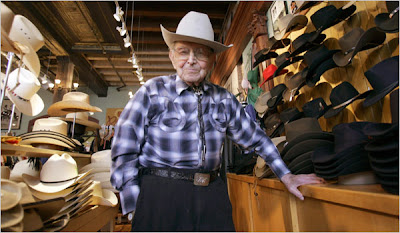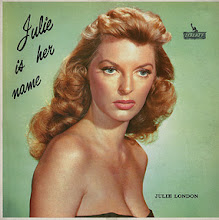Jack A. Weil, the Cowboy’s Dresser, Dies at 107

Jack A. Weil, a garter salesman, breezed into Denver in 1928 in a new Chrysler Roadster to start a new life. He exceeded his hopes and became a king of cowboy couture — almost certainly the first to put snaps on Western shirts (17 on a shirt), and most likely the first to produce bolo ties commercially.
Rockmount Ranch Wear Mfg. Co.
A style that became a classic.
His Rockmount Ranch Wear Mfg. Company has sold millions of shirts, including at least one shipment to Antarctica, since it started in 1946. Clark Gable wore one in “The Misfits” with Marilyn Monroe, and Heath Ledger’s shirt in “Brokeback Mountain” — plaid fabric, diamond snaps and saw-tooth pockets — was Style No. 69-39.
Until Wednesday, when he died at 107 in Denver, Mr. Weil was still chief executive of the company he founded and, until just before his death, came to work daily. He was regularly called the oldest chief executive still working.
Known as Papa Jack, Mr. Weil said he owed his longevity to quitting smoking at 60 (after starting at 40), drinking at 90 and eating red meat at 100. He did have a medicinal shot of Jack Daniels twice a week .
In announcing the death, his grandson, Steve Weil, Rockmount’s president, said Mr. Weil was to Western shirts what Henry Ford was to cars, and, indeed, the global spread of cowboy style owes much to him.
The shirt — tailored close to the body, with “yokes” that seem to broaden the shoulders of cowpokes and city slickers alike and often with distinctive “smile” pockets — offers more than snaps. But snaps matter, not least to cowboys who are not handy at sewing. They break loose easily if the shirt is caught on a hostile horn. (They also offer a dramatic way to bare one’s chest, but that might be another story.)
Jack Arnold Weil was born on March 28, 1901, in Evansville, Ind., where his father, Abraham, had come to avoid being impressed into the Prussian army in the Franco-Prussian War.
Jack and his brother, Edgar, delivered newspapers, outdoing other youths by using a horse and buggy, not bicycles. In World War I, young Jack inspected dungarees for shipment to the Navy.
Mr. Weil took a job selling garters and suspenders, first in the Midwest, then in a territory sprawling from El Paso to Canada. He fell instantly in love with the Rocky Mountains and moved to Denver, where he put up a new-fangled neon sign that flashed “Garters.”
He joined Phillip Miller in a company that later became Miller Stockman, another celebrated brand of Western clothes. It was called the Stockman Farmer Supply Company.
“The first thing I did was get rid of the farmer,” Mr. Weil told Denver Westward in 2001. For the rest of his life, he sold the romance of the cowboy. Mr. Weil was a crafty promoter. In Cheyenne, Wyo., he persuaded the Chamber of Commerce that it would be a great idea for everybody to dress Western for the Frontier Days rodeo; fines for failing to do so went to charity. Of course, Mr. Weil gave a deal on the clothes.
In 1946, Mr. Weil formed Rockmount, an abbreviation of Rocky Mountains. With the metal shortages of World War II over, he made diamond-shaped metal snaps, often with mother-of-pearl covers, the basis for his new business. Before long, Rockmount was selling Western fashion from belts to blouses.
Various accounts say Mr. Weil either invented the modern bolo tie (a necktie made of cord with a decorative slide), or named it. Both assertions are questionable. But Rockmount’s claims to have been the leader in mass-producing them seem widely accepted.
Mr. Weil still had his shirts made in America long after his competitors moved overseas; he also refused to favor big chains like Wal-Mart over his traditional customers.
“I never wanted to be the richest man in the cemetery,” he said.
His wife of 64 years, the former Beatrice Baum, died in 1990, and their son, Jack B., died this January. Mr. Weil is survived by his daughter, Jane Romberg, of Steamboat Springs, Colo.; five grandchildren; and 10 great-grandchildren.
Mr. Weil was a creature of habit, driving an old Dodge. But he could not understand why people would collect old Western shirts. He was aghast when his grandson Steve excitedly called to say he had found an original Rockmount shirt and that the dealer had accepted two new shirts for it.
“What?” Jack exclaimed. “You traded two perfectly good new shirts for an old one we sold for three dollars 40 years ago?”


0 Comments:
Post a Comment
Subscribe to Post Comments [Atom]
<< Home